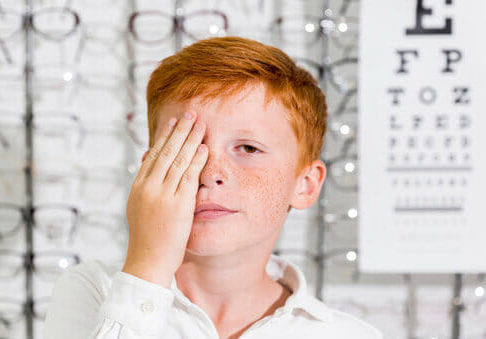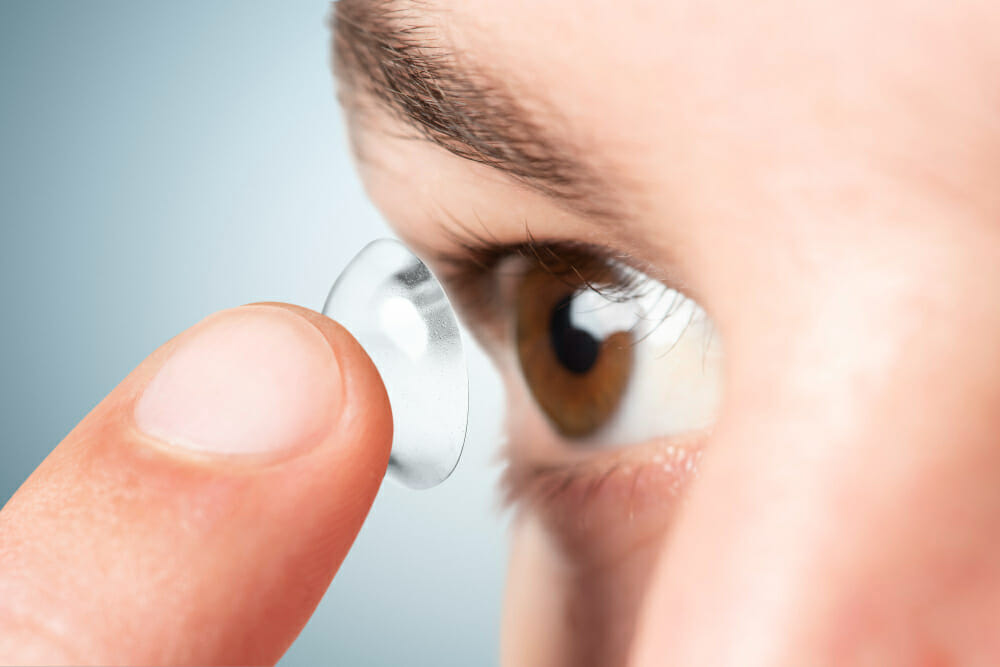What is myopia management?
Myopia management is an active treatment seeking to slow down the progression of myopia, and thereby reducing the risk of developing vision threatening ocular diseases associated with high levels of myopia. With myopia management this will not only provide clear vision but aim to slow the growth of the eye and thus slow the change in prescription over time. There are various myopia management treatment options including ortho-keratology specialty hard lenses, specialty multifocal contact lenses, and atropine eye drops. Consult your eye doctor today to determine which treatment option is right for you.
What is the cause of myopia?
Myopia is when the cornea, the front curvature of the eye, is too strong or the eyeball is too long, resulting for a person to see blurry far away. There are both genetic and environmental causes for myopia. In regards to family history, if both parents have myopia, there is a 50% chance the child will develop myopia. If one parent has myopia, there is a 33% chance the child will develop myopia. But even if neither parent has myopia there is a 25% chance the child will develop myopia. There are also environmental factors that can cause/be risk factors of myopia. For example if a person does excessive near work, spends more than 2 hours per day on digital devices, or spends less than 90 minutes a day outside, these can all increase the risk of developing myopia.
What is pre-myopia?
Pre-myopia is the stage right before a patient starts to develop a minus prescription. Pre-myopia is a refractive state of an eye that is between +0.50-+0.75D of hyperopia, and when a child has an increased risk of developing myopia in the future based on other factors as well. It is important to identify this stage to intervene and start discussing methods to prevent the onset of myopia. At this point, your eye doctor may recommend you spend more time outdoors (at least 2 hours per day), reduce the amount of time spent on near tasks or on digital devices, or begin taking low doses of atropine depending on how high your risk factors are for myopia. Be sure to have regular comprehensive eye exams so your eye doctor can determine what the best course of treatment is for you.
Does myopia get worse with age?
Myopia usually appears in childhood and as a child grows, especially during their critical growth period, their myopia can get worse with age. Typically once a person reaches 18 years old, or after college when they are done with prolonged near work, the myopia tends to stabilize. However, to prevent myopia from reaching high levels, which can then lead to various sight threatening ocular diseases, it’s important to try to slow down the progression of myopia. Therefore, talk to your eye doctor today about various myopia management treatment options to help slow down the progression of your myopia.
What Ortho-Keratology is and how does it work?
Ortho-Keratology lenses are specialized custom-made hard contact lenses that are worn overnight and use a reverse geometry lens design. Ortho-K lenses gently reshape the front curvature of the eye to temporarily reduce the amount of myopia (nearsightedness) during the day. It can take up to 1-2 weeks to get the eye to get to the shape it needs to be in order to see clearly throughout the whole day without any glasses or contact lens correction. The ortho-K lenses that are worn overnight will mold the cornea in a specific shape such that then when light enters the eye it focuses properly on the central and peripheral retina allowing the patient to not only see clearly but this helps to slow down the progression of myopia. According to the peripheral defocus theory, the whole issue with progressing myopia is that light does not land properly at the peripheral retina, resulting in a biochemical feedback loop to cause the eyeball to elongate and increase in myopia. But, with this corneal reshaping therapy this ensures that light will then land properly at the peripheral retina, thereby reducing the signal for the eyeball to elongate and essentially slowing down the progression of myopia. Thus, ortho-K lenses don’t just help you see clearly but they also help in slowing down the progression of myopia.
What is severe or high myopia?
Severe or high myopia is when your refractive error is greater than or equal to 5-6.00 Diopters of myopia.
How does the Ortho-K slow the progression of childhood myopia.
Ortho-Keratology lenses are specialized custom-made hard contact lenses that are worn overnight that gently reshape the front curvature of the eye to temporarily reduce the amount of myopia (nearsightedness) during the day. It can take up to 1-2 weeks to get the eye to get to the shape it needs to be in order to see clearly throughout the whole day without any correction. The ortho-K lenses that are worn overnight will mold the cornea in a specific shape such that then when light enters the eye it focuses properly on the central and peripheral retina allowing the patient to not only see clearly but this helps to slow down the progression of myopia. According to the peripheral defocus theory, the whole issue with progressing myopia is that light does not land properly at the peripheral retina, resulting in a biochemical feedback loop to cause the eyeball to elongate and increase in myopia. But, with this corneal reshaping therapy this ensures that light will then land properly at the peripheral retina, thereby reducing the signal for the eyeball to elongate and essentially slowing down the progression of myopia.
How does the Ortho-K assist in treating nearsightedness, and astigmatism.
Ortho-Keratology lenses are specialized custom-made hard contact lenses that are worn overnight that gently reshape the front curvature of the eye to temporarily reduce the amount of myopia (nearsightedness) during the day. It actually can take up to 1-2 weeks to get the eye to get to the shape it needs to be in order to see clearly throughout the whole day without any correction. The ortho-K lenses that are worn overnight will mold the cornea in a specific shape such that then when light enters the eye it lands properly on the retina allowing the patient to see clearly, whether they have nearsightedness or astigmatism.
Can I stop myopia from getting worse?
There are various myopia management treatment options available to slow down the progression of your myopia. These include ortho-keratology speciality hard lenses, speciality multifocal contact lenses, and atropine eye drops. Consult your eye doctor today to determine which treatment option is best for you.
Why is my myopia/nearsightedness increasing?
As you grow, your eyeball grows longer resulting in your myopia to increase. However there are certain factors that can exacerbate the rate of your myopia progressing, some that are in your control and others that are not. There can be genetic factors that can increase your risk of developing higher levels of myopia, for instance if both of your parents are myopic this increases your risk of myopia. However, there can also be environmental factors as well. For instance, if you spend a prolonged period of time on digital devices (more than 2 hours per day) or do excessive near work in dim lighting, or spend very little time outdoors (less than 2 hours per day) this can all increase the rate of myopia progression. As your myopia progresses this places you at a higher risk of developing various sight-threatening ocular diseases, so be sure to consult your eye doctor today on various myopia management treatment options to help slow down the rate of your myopia progressing.
Is high myopia dangerous?
Yes. High myopia significantly increases your risk of getting various sight threatening ocular diseases, such as myopic maculopathy, retinal detachments and glaucoma. If you have 6.00D or more of myopia the risk of you getting myopic maculopathy increases by 40x whereas if you have low levels of myopia, like -2.00D, the risk of you getting myopic maculopathy is only 2x. Consult with your eye doctor about various myopia management treatment options.
What are the benefits of Ortho-k for kids?
Ortho-K are specialty hard contact lenses that are worn overnight to gently reshape the front curvature of the eye such that then when the patient wakes up in the morning and removes the lenses they are able to see clearly throughout the day without any glasses or contact lens correction. This modality is great for kids who are involved in sports. Ortho-K is also a good alternative for kids who are not compliant with wearing their glasses. Ortho-K lenses can also help improve a patient's self esteem if they feel self conscious having to wear glasses. Another huge benefit of ortho-K for kids is, other than ortho-K providing clear vision throughout the day without any glasses/contact lens correction, it also helps to slow down the progression of a patient’s minus prescription reducing the patient’s risk of getting various sight threatening ocular conditions down the road.
When will the ortho-k lenses start working?
The rate of orthokeratology treatment will vary slightly per patient. On average, the first night of treatment will correct 50-75% of a patient’s baseline prescription. The average treatment period for full correction can take up to 1-3 weeks.
Is it true that wearing CRT or OrthoK lenses means I don't need to wear glasses?
Yes, orthoK lenses are designed such that you wear them overnight where they gently reshape the front curvature of the eye to temporarily reduce the amount of myopia (nearsightedness) during the day so you don’t need to wear glasses throughout the day. However it can take up to 1-3 weeks to get the eye to get to the shape it needs to be in order to see clearly throughout the whole day without any glasses or contact lens correction. However, it's vital that you have a backup pair of glasses in the event that you develop a contact lens related infection that forces you to take a break from your contacts.




